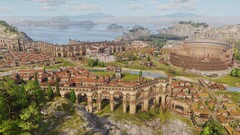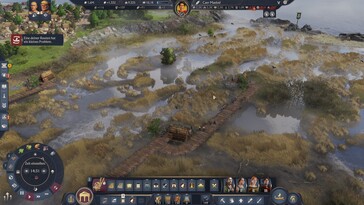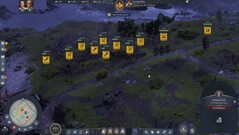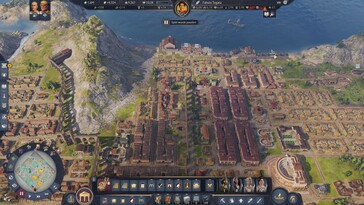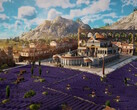We were able to test Anno 117 before its release, not only as part of an upcoming tech review but also by exploring the gameplay mechanics in depth. It should be noted that Anno 117 is a massive game, and we weren’t able to finish it during our test period of roughly 15 hours. For example, our Colosseum is still awaiting completion and the extensive research tree has yet to be fully explored. That said, we’re ready to share our first impressions of the new Anno game.
The swamp is a curse or resource supplier
The good news first: anyone who likes Anno will at least enjoy or even love this latest installment. Anno 117 introduces several new features right from the beginning of the game. In sandbox mode, players can choose whether they start in Latium or Albion, meaning in the Roman heartland or the region corresponding to modern-day Great Britain.
Players are immediately informed that Albion is the more challenging starting region, which we can generally confirm. However, starting in Albion is not exactly an insurmountable challenge even for beginners. That said, the swamp area involves a rather unusual gameplay mechanic. Certain goods, such as eels, can only be produced in this swamp, which can alternatively be drained thanks to researchable technologies in order to gain valuable building land, particularly in Albion.
When advancing through levels in Albion, players can choose between a Germanic or Roman path, which in turn determines the needs of the evolving population.
Puzzle mechanics for multifaceted cities
The gameplay follows the classic Anno formula. Production buildings generate goods, sometimes through multi-stage production chains, which are used as construction materials and to meet the needs of residents. To level up the population, not all needs have to be fulfilled, which allows for faster expansion. However, this freedom of choice is somewhat relative. Meeting specific needs offers advantages, for example, tax income from residents increases when nonessential needs are satisfied.
The same applies to certain production buildings with area effects. If residential buildings are close to a sardine hut, they generate additional income. The impact of these area effects should not be underestimated and can certainly make a difference in the treasury, though they are not always beneficial. For instance, the marble mason increases the prestige of surrounding buildings while reducing their health.
This means that Anno 117 becomes somewhat of a puzzle game and actively encourages the integration of production buildings into the main city. This creates visual variety and prevents settlements from looking too uniform. However, the new Anno installment misses an opportunity for true mixed-use areas. In ancient Rome, there were buildings in which workshops and stores occupied the first floor. That would likely have required a modular construction system but would have made cities visually more diverse and opened up new possibilities. True to Anno tradition, population density increases with each civilization level, so patricians no longer live in spacious domus houses but in elegant tall buildings.
Diagonal streets and flowing water
The area effects also relate to a new gameplay mechanic, namely aqueducts. Water can be transported from the mountains down to lower areas and provides major benefits for resident’s happiness and health. The productivity of farms and mines can also be greatly increased with water supply. If aqueducts are not planned in advance, city builders will often have to deal with significant demolitions or relocations. While that may sound tedious, it actually adds an interesting layer to the gameplay.
Anno 117 is also the first installment in the series to support roads at a 45-degree angle. Without losing usable building space, this feature mainly works for farms that now support half-square tiles. Still, this new road-building option allows for more visually diverse cities if players want them to be.
Research, religion and specialists for more complexity
Another powerful new gameplay mechanic is the research system. It’s important right from the start and provides access to building upgrades and alliance options, among other things. The research tree is divided into three branches, namely economy, civil society and military. Advanced technologies are heavily tied to milestones. In addition to generating a certain amount of knowledge, players must also meet specific requirements, such as building several mines or aqueducts or reaching certain population levels.
Anno 117 also includes a full-fledged religion system that unlocks significant bonuses. Worshiping Ceres, for instance, massively boosts agricultural production. The game distinguishes between global and local effects. The strong local effects make it impractical to separate production and residential parts like in Anno 1800, especially after the introduction of the commuter pier and the establishment of a global workforce reserve. In Anno 117, workers simply cannot commute to other islands, so it is necessary to build multiple functioning settlements.
Specialists who can be housed in your villa or officium must first be purchased, researched or recruited through festivals and can also provide considerable bonuses.
To arms, now also on land
Anno 117 introduces more extensive military options. There is once again true land combat with different unit types, each with specific strengths and weaknesses. Catapults are useful for destroying enemy fortifications, while archers should not be placed in the front line. Your own settlement, and especially your villa, can and should be protected by defense towers and walls in times of war or during uprisings.
Naval combat benefits from the modular design of ships. Depending on the ship, several modules can be attached to make them more effective against buildings, for example. During our review, we were able to eliminate one of the weaker pirates and another AI praetor via land combat. Hs stronger pirate brother in Latium agreed to a truce after costly battles, but to the emperor’s disapproval. Our actions not only affect relations with other rulers but also influence our standing with the emperor, which can lead to war in the worst case.
Anno 117 has a strong competitor in Anno 1800
Anno 117 is a major evolution but not a revolution for the series and a very good game that likely is a must-play for fans of city-building and strategy games. The new features blend into the familiar Anno atmosphere. The research system can sometimes cause some short downtime, but in most cases it provides a smoother progression and gradually introduces new gameplay mechanics.
Religion grants significant bonuses, especially in the mid-game. The bonus system can lead to deeper structural adjustments within settlements and it also rewards players with powerful boosts and visually diverse cities. In terms of visuals, Anno 117 ranges from very pretty to stunning, depending on your hardware.
The main issues might be the rather steep learning curve. In addition, rapid expansion can quickly cause imbalances in terms of fire risk, happiness and health, since larger cities face significant penalties depending on the difficulty level. We did not encounter any kind of death spirals during our review, and the difficulty can be adjusted gradually even during gameplay.
That being said, the interface takes some getting used to, even for Anno veterans. The statistics interface is useful, but we would like to see more helpful features here, such as an indicator that shows how many production buildings at a certain efficiency are needed in order to meet the demand. Whether Anno 117 can match Anno 1800 will likely become clear after the release of its DLCs, but overall, Anno 117 is already well worth the $60 price tag.
Either way, there are several noteworthy alternatives in this genre. Captain of Industry offers even more complex production chains and a modern setting. Foundation features a more flexible building system, while Farthest Frontier has survival elements, seasons and food spoilage. Kingdoms Reborn is another gem that’s highly regarded by the author and sports an intriguing research system and various civilizations with unique gameplay mechanics.
Technically, the game performed well on our test system with an AMD Ryzen 9 3900X, an Nvidia GeForce RTX 2080 Super and 32GB RAM. On high graphics settings, this GPU-heavy title ran at a smooth 40 frames per second. With DLSS in balanced mode, we got around 10 fps on top. For a more detailed analysis of the game, we refer to our in-depth tech review. Lastly, we encountered no bugs during our test.




